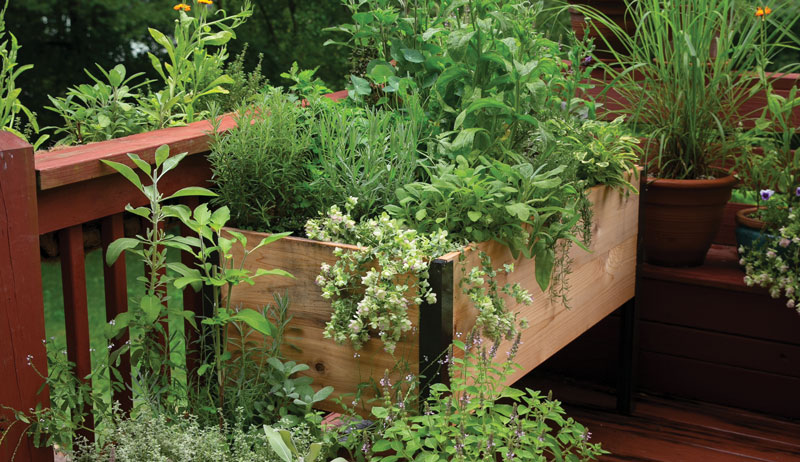
If you’re tight on garden space, you’ll be delighted to know there are bushels of healing plants that you can grow in pots. And even if you have heaps of soil, you’ll be pleased to learn about the habitats you can create with containers. By choosing the appropriate planter, soil and location, you can extend the growing season or simulate a drier or wetter environment, expanding the range of plants you can grow.
If you adorn your deck or porch with potted flowers every spring, there’s a multitude of splashy herbs that can stand in for bedding plants. Herbs with edible flowers, such as calendula, pineapple sage, anise hyssop, chives, heart’s-ease and nasturtium, brighten up planters and can add contrast to leafy culinary herbs such as parsley, basil or sage. I’m partial to the gray foliage of artichoke and the silvery lavender and thyme cultivars. The classic Mediterranean culinary herbs—basil, thyme, sage, parsley, chives, rosemary and lavender—happily hop into most any container. Place them in the front or back door to make them easy to reach for when you’re cooking. Mint, stinging nettles, bee balm, horsetail, calamus and jiaogulan are just a few plants that can overtake their surroundings in the garden; rein in these spreading botanicals with a container.

A Tour of Containers
When selecting a planter, consider its size, shape, and construction. Larger vessels hold in moisture and need to be watered less frequently. In contrast, smaller containers sometimes need to be watered daily. You’ll also want to think about how heavy it will be when filled with soil. Shallow, broad pots provide a homey environment for low-growing, spreading herbs like gotu kola, sweet violet, and thyme. Taller planters offer easy access to plants when mobility is a consideration.
Bathtubs, Washtubs & Sinks
Retired tubs and sinks are some of the greenest options available, as they’re destined for the landfill. They are long-lived, resistant to cracking from temperature fluctuations, and can provide a sizeable growing area that holds moisture quite effectively. Know that cast-iron tubs covered with porcelain glazes manufactured before 1995 can contain lead. Reproduction washtubs are a fun option, and many come with a stand putting the plants in easy reach.
Read more: Check out this video how-to for refinishing an old farmhouse sink!
Plastic Pots
Plastic nursery pots and food-grade buckets are lightweight, affordable and sometimes free. The downside of plastic vessels includes their shorter life span and environmental toll. However, landscapers and nurseries often throw out plastic pots, so reuse helps keep them out of landfills. There is a possibility that chemicals, some of which are endocrine disruptors, might leach from the plastic into the soil and enter the plants via their roots, but I haven’t found any studies researching this topic.
Terra-Cotta Pots

Terra-cotta, or clay, pots wick away moisture quickly, so plants in terra-cotta pots need to be watered frequently. Unglazed terra-cotta will crack and break if left outdoors and filled with soil during freezing temperatures.
Glazed Ceramic Planters
Offered in a variety of colors and textures, glazed ceramic pots retain more moisture than terra-cotta pots and are less likely to crack during the winter. But they are heavy, expensive, and I suspect some of the glazes may contain lead; however, I haven’t been able to verify this, despite extensive research.
Read more: These 6 plants are great options for a medicinal herb garden.
Fiber Pots
These natural pots are compostable and made from peat, manure, or pulp by-products. They typically last one season or less. Many people prefer using these over plastic because they are biodegradable, but unfortunately most are manufactured overseas and carry the environmental impact of transportation.
Wooden Containers

Wine and whiskey barrels offer charm, a considerable planting area, and superior water retention due to their size. Tall wooden planters (like the one pictured here) also fall into this category; these offer easy access for folks in wheelchairs or with limited mobility. Avoid pressure-treated wood as it contains toxins that leak into the soil.
From The Healing Garden by Juliet Blankespoor. Copyright © 2022 by Juliet Blankespoor. Reprinted by permission of Harvest, an imprint of HarperCollins Publishers. The book comes with an online portal of free gardening charts, ten video tutorials, and regional herb gardening profiles. For booksellers and book bonuses, visit HealingGardenGateway.com.




